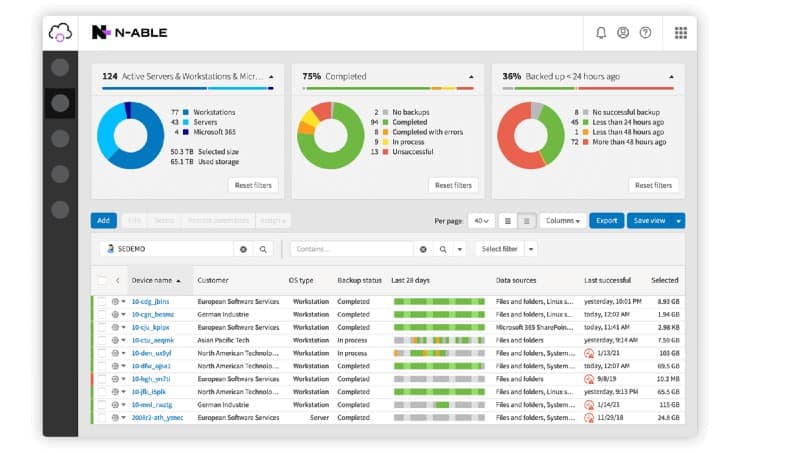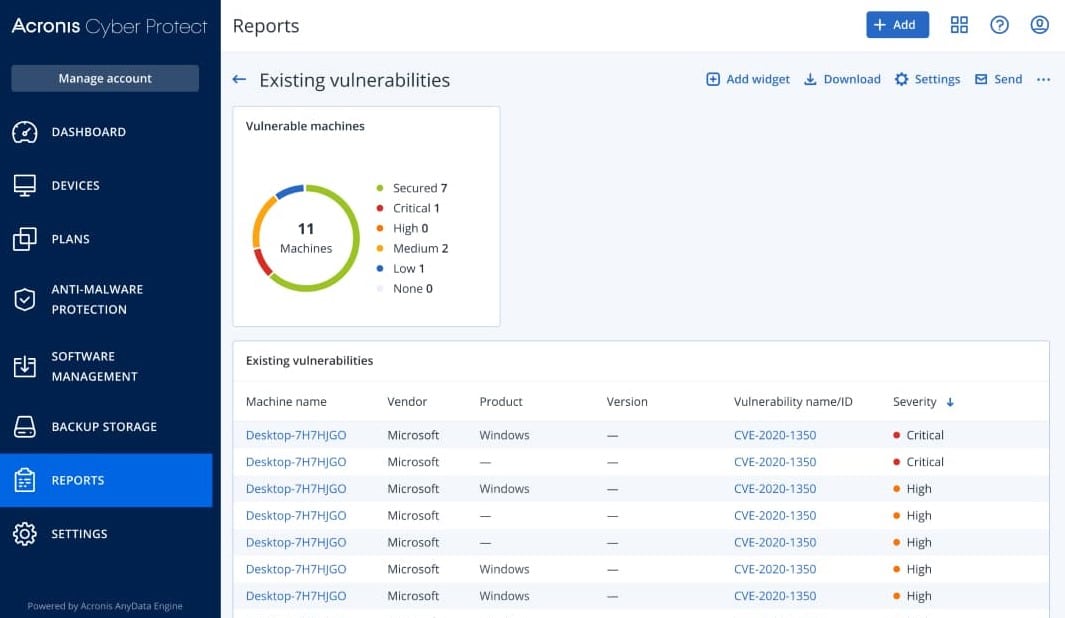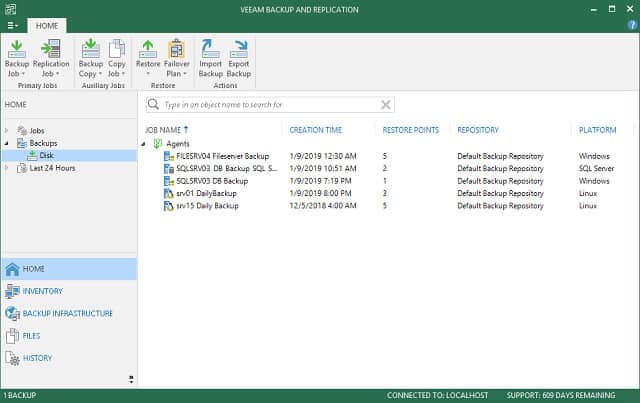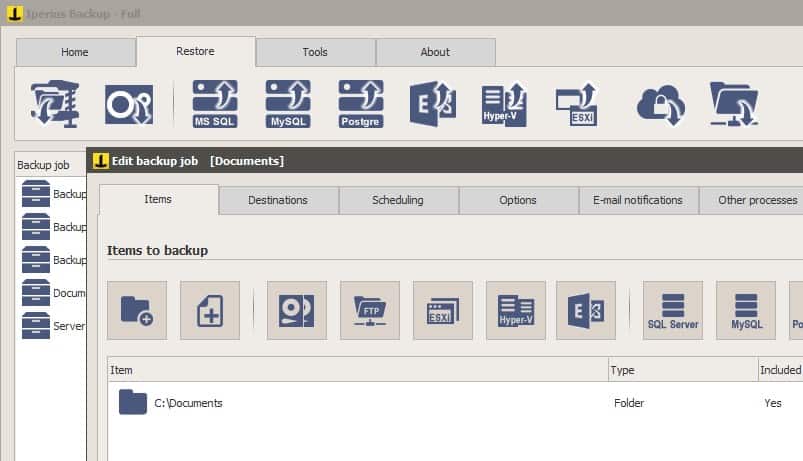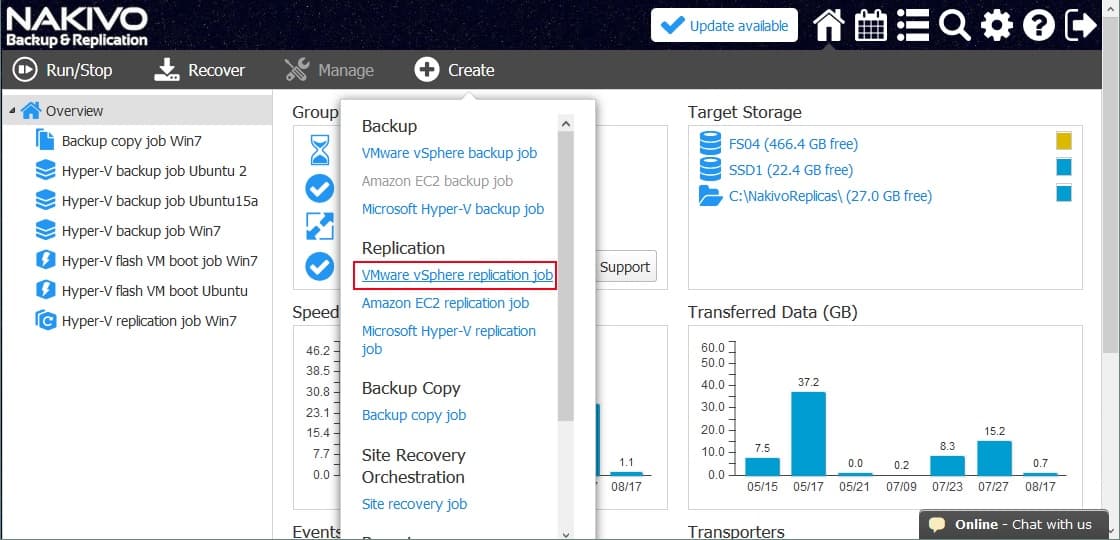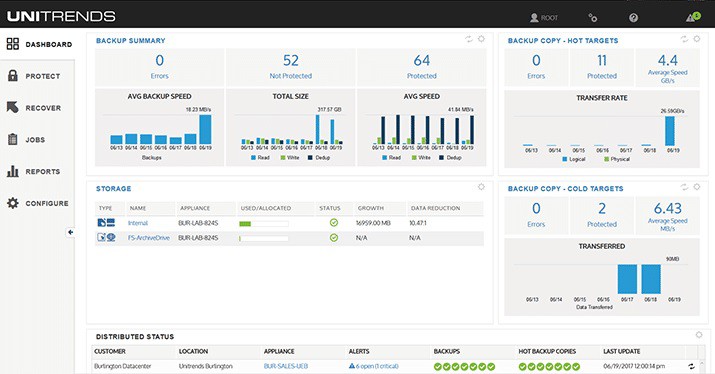VMware backup solutions perform backups of virtual machines (VMs) running on VMware virtualization infrastructure. Specifically the backup and recovery of VMs and associated data, ensuring the protection and availability of virtualized environments.
There are multiple solutions on the market which provide a range of features and scalability options to cater to different environments and organizations.
Here is our list of the ten best VMware backup tools:
- N-able Cove Data Protection EDITOR’S CHOICE This cloud-based backup system lets you choose to back up specific data stores and a list of applications, including VMware. Each service can have different backup settings. Get started with a 30-day free trial.
- Acronis Cyber Protect (FREE TRIAL) This cloud-based package of endpoint protection services includes a backup tool for both physical and virtual systems. Start a 30-day free trial.
- Veeam Backup & Replication A backup and restore service for cloud, physical, and virtual resources that includes routines for backing up VMware. It is available as a cloud service for on-premises installation on Windows Server.
- Vembu BDR Suite A backup system for VMware and also Hyper-V, Windows Server, workstations, AWS, and productivity suites. It is available for Windows, Windows, Server, and Ubuntu Linux.
- Hornetsecurity VM Backup & Replication A backup service specifically for virtual machines with a version for VMware and another for Hyper-V implementations. It installs on top of VMware virtualizations.
- Iperius Backup A backup and restore service that covers VMware and Hyper-V virtualizations. It runs on Windows and Windows Server.
- Nakivo Backup and Replication A backup system with ransomware protection included that has capabilities for supporting many well-known applications, including VMware virtualizations. It runs on Windows and Windows Server.
- Storware Backup and Recovery A flexible backup system for virtualizations, operating systems, file servers, and applications. It runs on CentOS and RHEL Linux.
- Unitrends Backup Implemented on a hypervisor as a virtual appliance, this backup system is suitable for VMware and Hyper-V systems and is available in free and paid versions.
- VSquare Backup Offers backup services for VMware, Hyper-V, and entire PCs. It installs on Windows and Windows Server.
VMware is the market-leading virtualization provider. Its products hold both the number one and number two slots in terms of the number of companies using virtualizations. These are vSphere with an 11.7 percent market share and ESX Server with an 11.22 percent share. Microsoft Hyper-V is in the number three position with 10.68 percent of the market.
There are two terms related to VMware – “virtualization” and “hypervisor.” While virtualization refers to the concept, a hypervisor is a software that creates virtual machines. Effectively, the two terms are interchangeable.
Backing up virtualizations is a flexible concept because all the hypervisor has is a mapping between an imagined architecture and the real, physical, underlying system. When you back up systems, you need to copy all of the data that the system uses. It isn’t usual to copy software because that is usually available on disks or through downloads. However, reinstalling software usually loses its settings. In addition, the configuration of a hypervisor can take a lot of work to set up, so having to go through the whole process again if a physical server gets damaged and needs to be replaced can be very time-consuming.
Backing up VMware
Backing up VMware can mean two things – copying over its configuration or extracting all of the data contained within the system represented by the hypervisor. Of course, you will need to backup all of your data anyway, so you can do that within the structure that the hypervisor creates or get under the VMware software and just take a snapshot of the entire disk.
Another complication when looking into VMware backup services is that some declare that they back up the virtual servers. In contrast, others say they backup the entire hypervisor. Of course, In reality, no one would just want to copy the server and leave out the virtual switches and VM mapping – so effectively, systems that say they only copy the server really also save the structure of the entire hypervisor. However, don’t expect the backup tool to copy over the VMware software package in all cases.
The best VMware backup tools
When looking into a really good backup system for VMware you need to adapt your search according to your current system and personal architecture preferences. In other words, you will probably prefer to have on-premises software or a cloud service. Similarly, if you already have your own cloud storage server contract sorted out, you will probably want to use that. Otherwise, you might prefer to find a system that has cloud storage included in the plan.
Our methodology for selecting a VMware backup tool
We reviewed the market for systems to backup VMWare and analyzed the options based on the following criteria:
- The option to just store virtual host settings
- Integration with native VMWare backup system
- Rollback versions
- Automated recovery to reverse tampering
- An easy-to-use system
- A free trial or a demo package to enable testing before paying
- Value for money, represented by a reliable backup and recovery service at a fair price
Using this set of criteria, we looked for backup and recovery systems for VMWare and other virtualization systems.
1. N-able Cove Data Protection EDITOR’S CHOICE
N-able Cove Data Protection is a cloud-based service and is provided by the MSP division. This section offers system monitoring and management software to managed service providers. For this reason, the service is built as a multi-tenanted system. MSPs can use it directly to back up the systems of their customers or resell it, giving each customer direct access to their own sub-account to organize backups. The service can also be used by IT professionals that work in-house to support a business’s system.
Key Features:
- Automated VMware Backup: Automates the process of backing up virtual machines (VMs) running on VMware vSphere environments.
- Application-Aware Backups: It offers application-aware backups, which understand the specific needs of applications, ensuring application consistency during restore operations.
- Incremental and Full Backups: The solution supports both incremental and full backups. Full backups capture the entire VM, providing a complete recovery point.
- Instant Recovery: Allows for instant recovery of individual files, folders, or entire VMs directly from backups.
- Server or Virtualization Backup: Users have the choice of backing up servers or virtualized environments, catering to different IT infrastructures and setups.
Why Do We Recommend It?
N-able Cove Data Protection is a strong contender for VMware backup solutions, especially for businesses with critical applications, disaster recovery needs, or existing N-able environments.
Within the browser-based console, the user can select from a series of applications which to back up, and VMware is included in that list. Each application can have different backup settings. The service will create a local copy of the virtualization and from that store, upload the copy to the N-able cloud server. Both the transfer across the internet and the storage are protected by 256-bit AES encryption, which is considered uncrackable.
The advantage of the two storage locations is that restoring the system from the local copy is much faster. However, inevitably, the local copy shares vulnerabilities with the original, live system. Once you have a full copy in storage, the service will perform incremental updates, only copying over data that has changed. That copy in the cloud has other uses because there is nothing to stop you from using it to replicate a VMware implementation in another location.
Who Is It Recommended For?
N-able Cove Data Protection can be a valuable solution for various businesses and organizations that place importance on reliable backup and disaster recovery for their VMware environments, especially if they have critical applications or require a scalable solution.
Pros:
- Cloud Backup and Disaster Recovery: Provides an extra layer of protection against data loss due to on-site disasters.
- Granular Recovery Options: Allows for flexible recovery depending on your specific needs.
- Centralized Management: Simplifies backup management from a single, user-friendly dashboard.
Cons:
- Cost: N-able Cove Data Protection is a paid service with different licensing options depending on the number of VMs and features required.
This is a well-planned, easy-to-use system that has strong security and can generate extra income for MSPs. You can get a 30-day free trial.
EDITOR’S CHOICE
N-able Cove Data Protection is our number one pick for a VMware backup service because it backs up all of the virtual infrastructures. The backup system is based in the cloud and it operates both on the local system, storing a copy on-site, and on the cloud with secure storage included with a subscription. This gives double value because the local copy provides a fast restore service and the cloud-stored copy provides protection against an onsite disaster.
Start 30-day FREE Trial: n-able.com/products/cove-data-protection/trial
Operating system: Cloud-based
2. Acronis Cyber Protect (FREE TRIAL)
Acronis Cyber Protect is a cloud-based package that provides system-wide security by protecting endpoints. As this is a cloud-based service, it isn’t bound by one network and can supervise endpoints in several locations. This is ideal for managing devices in the service of work-from-home employees.
Key Features:
- Charged Per Host: Acronis Cyber Protect is priced per host, making it scalable and cost-effective for businesses of different sizes.
- Virtual Appliance: The solution runs as a virtual appliance, simplifying deployment and management within virtualized environments.
- Malware Scans: Acronis Cyber Protect includes malware scanning capabilities, enhancing cybersecurity by detecting and mitigating threats.
- Support for Multiple Virtualization Platforms: The platform is compatible with various virtualization platforms, including Hyper-V, Citrix Xen, RedHat, KVM, and Oracle VM.
Why Do We Recommend It?
Acronis Cyber Protect provides a complete package for VMware backups, integrating data protection, disaster recovery, and cybersecurity features. This makes it a top choice for businesses worried about security, compliance requirements, or needing disaster recovery options with different hardware.
The Acronis backup system servers many different applications and VMware
The Cyber Protect package includes a backup system. This is offered with a range of capabilities, including the ability to backup virtual systems. This includes VMWare vSphere instances. Pricing for this tool is levied per server with no charge per VM. Acronis Cyber Protect is also able to back up Hyper-V systems.
System administrators get a choice of repository locations for their backups. They can be sent to removable storage, to an on-site server on a different site, to a private cloud server, to a public cloud system, such as AWS or Azure, and there is also an option of storing backups on the Acronis Cloud service.
The dashboard for Acronis Cyber Protect is hosted in the cloud and can be accessed from anywhere through any standard Web browser. The console is able to locate all of the services that are to be protected and also their hosts. This enables the dashboard to show the statuses of each VM and offers a one-click restoration in the event of a disaster.
The Acronis Cyber Protect system also includes a patch manager and an anti-malware system. As well as protecting endpoints, the Acronis anti-malware scans all data before it is uploaded to the backup repository.
Who Is It Recommended For?
Acronis Cyber Protect is ideal for businesses that emphasize data security, compliance, and thorough disaster recovery, in addition to VMware environment backups.
Pros:
- Backup Service for Virtual Machines: Acronis Cyber Protect offers backup services for both VMWare and Hyper-V virtual machines, ensuring data protection and recovery capabilities for virtualized environments.
- Anti-Malware Protection: The solution provides anti-malware protection, safeguarding systems and data against malicious attacks and cybersecurity threats.
- Patch Management: Acronis Cyber Protect includes patch management features, allowing users to manage and apply software updates and patches to enhance system security and performance.
Cons:
- Separate Subscription for Additional Systems: While the platform supports various virtualization platforms, other systems such as databases may require separate subscriptions, potentially increasing overall costs.
Acronis Cyber Protect is offered in five editions, each with a different combination of services. You can assess the system with a 30-day free trial.
3. Veeam Backup & Replication
Veeam Backup & Replication is one service that is built into a stack of cloud services. Although it is part of a larger platform, it is possible to take on this system as a standalone utility. The Veeam backup system is a cloud-based service.
Key Features:
- Multi-Threaded: Veeam Backup & Replication utilizes multi-threaded processing, enabling efficient and simultaneous backup operations for improved performance.
- Fast Recovery: The platform offers fast recovery capabilities, allowing users to quickly restore data and services in the event of system failures or data loss.
- Hyper-V Backup: In addition to VMware backup, Veeam Backup & Replication also supports backing up Hyper-V environments, providing versatility for virtualized infrastructures.
Why Do We Recommend It
We recommend Veeam B&R for its comprehensive features, scalability, reliability, and potential for integration within existing IT environments.
The user can choose which services and data should be included in the backup plan. It is able to cover operating systems, data stores, services, and applications. Among the applications covered by Veeam Backup & Replication is VMware. The system can also manage backups for Hyper-V.
Veeam prides itself on its proprietary Instant VM Recovery system, which uses multi-threading and parallel connections to restore multiple VMs simultaneously. The service can also be used for migrations and replication.
Who Is It Recommended For?
Veeam B&R is recommended for businesses with critical applications, disaster recovery plans, large VM environments, or existing integrations with compatible tools.
Pros:
- Choice of Cloud and On-Premises Configurations: Offers flexibility with a choice of cloud-based or on-premises backup configurations, catering to diverse IT environments and requirements.
- Backup for Multiple Platforms: The platform supports backup for VMware and Hyper-V virtualization platforms, as well as other applications.
- Whole Server Backups: Users have the option to perform whole server backups, ensuring complete protection of server environments and simplifying recovery processes.
Cons:
- Cost Considerations: Veeam Backup & Replication can be expensive, especially for larger deployments or when utilizing advanced features and functionalities.
As this is an online service, you don’t have to worry about maintaining the software – all updates to the system occur behind the scenes on the Veeam server. This is a quick and efficient backup and replication service that is easy to use and cost-effective. The tool will backup VMware vSphere 5.5, vSphere 6.x, and vSphere 7.0. There is also an on-premises version, which installs on Windows Server, for those who prefer to manage the software themselves. You can get a 30-day free trial of Veeam Backup & Replication.
4. Vembu BDR Suite
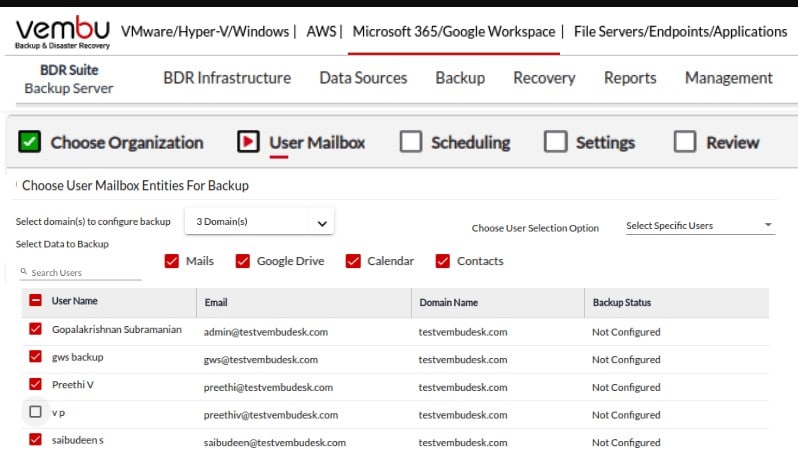
If you want an intuitive backup service for your VMware implementations then Vembu BDR Suite is worthy of your attention. BDR stands for Backup and Disaster Recovery. This is a great free tool for backing up VMWare, Hyper-V, Windows Server, entire workstations with Windows or macOS operating systems, Office 365, G Suite, and AWS EC2 instances.
Key Features:
- Whole Server Backup Option: Vembu BDR Suite offers the option to perform whole server backups, allowing users to protect entire server environments comprehensively.
- Server-Level or Application-Specific Backups: Users can choose between server-level backups or application-specific backups, providing granularity in data protection based on requirements.
- AES-256 Encryption: The platform utilizes AES-256 encryption for both data transfer and storage, ensuring data protection and security during backup operations.
- Hyper-V Backup: In addition to whole server backups, Vembu BDR Suite also supports backing up Hyper-V environments, catering to virtualized infrastructures.
Why Do We Recommend It?
Vembu BDR Suite stands out as a cost-effective and user-friendly VMware backup solution for businesses looking to balance affordability with core backup and recovery functionalities. The ease of use, efficient backups, fast recovery options, and scalability make it a strong contender for SMBs or organizations with budget constraints.
This all sounds so fantastic that you probably wonder what the catch is. As with any free version, there are limits on the capabilities of this free service. The system will back up 10 VMs with a useful service and then allow extra VMs to be backed up with service limitations.
Who Is It Recommended For?
Vembu BDR Suite is a great choice for businesses looking for a budget-friendly and easy-to-use VMware backup solution. It’s particularly good for SMBs, organizations with limited IT resources, and those with remote management needs.
Pros:
- Flexible Service Configurations: Offers flexibility in service configurations, allowing users to tailor backup and recovery strategies to their specific needs and IT environments.
- Cost-Effective: Vembu BDR Suite is known for being a competitive and affordable solution compared to some other VMware backup options.
- Free to Use: The platform provides a free version, enabling users to access basic backup and recovery functionalities without incurring costs.
Cons:
- Storage Space Not Included: One limitation is that storage space is not included with the platform, meaning users need to arrange for their own storage infrastructure, which may incur additional costs.
As well as the Free edition, there are four paid versions: Standard Essentials, Standard, Enterprise Essentials, and Enterprise. You can get the Standard edition on a 30-day free trial. If you decide not to buy at the end of the trial, the software switches over to the Free edition. This is on-premises software with versions available for Windows, Windows Server, and Ubuntu Linux.
5. Hornetsecurity VM Backup & Replication

Hornetsecurity VM Backup & Replication is an on-premises package that has different versions for VMware and Hyper-V. The Hyper-V version installs on Windows Server, by the VMware version runs on top of the hypervisor, so it is flexible as far as the underlying operating system is concerned.
Key Features:
- On-Premises Virtual Appliance: Utilizes an on-premises virtual appliance, which provides a dedicated and controlled environment for backup and replication operations.
- Migration, Distribution, or Replication: The platform offers capabilities for migrating, distributing, or replicating data, providing flexibility in data management and redundancy options.
- Hyper-V Backup: In addition to VMware backup, it also supports backing up of Hyper-V environments, ensuring compatibility with diverse virtualization platforms.
Why Do We Recommend It?
Hornetsecurity VM Backup & Replication is a cost-effective and user-friendly VMware backup solution with efficient backup processes, fast recovery options, and scalability. The ease of use and WAN-optimized replication make it suitable for geographically dispersed environments or organizations with limited IT resources.
The Hornetsecurity system operates an incremental update system after an initial full backup. A full backup can also be performed on-demand at any time. This service can also be used to migrate, distribute, or replicate VMware implementations.
This service can backup VMware instances on many sites, so it is a great option for businesses that have centralized their IT services. The backup system is lightweight and operates continuously in the background without the risk of freezing the hypervisor being backed up.
This service doesn’t include storage space. However, the Hornetsecurity system includes integrations for the major cloud storage providers, so backups can be forwarded seamlessly over the internet as well as being stored locally. It is also possible to designate business-owned storage on other sites as a target for backups.
Who Is It Recommended For?
Hornetsecurity VM Backup & Replication is recommended for businesses seeking a balance between affordability, ease of use, and core backup functionalities for their VMware environments.
Pros:
- Centralized Management: Offers a centralized management interface for monitoring and managing backup and replication tasks across multiple VMs or VM clusters, enhancing administrative efficiency.
- Backup for Multiple Sites: Supports backup operations for multiple sites, enabling centralized management of backup tasks across distributed environments.
- Local and Cloud Backup Storage: Users can store backups locally on-premises and also on a cloud server, providing redundancy and disaster recovery options for data protection.
Cons:
- No SaaS Option: It does not offer a SaaS option, which may limit deployment flexibility for organizations preferring cloud-based backup solutions.
Hornetsecurity VM Backup & Replication is available for a 30-day free trial.
6. Iperius Backup
Iperius Backup offers an interface for the Changed Block Tracking (CBT) feature of VMware ESXi Free. It also has a replication service for that system. This Iperius tool is also able to back up standard ESXi and vCenter implementations. This system is also available to back up Hyper-V implementations.
Key Features:
- Integration with Native VMWare Backup Processes: Integrates seamlessly with native VMWare backup processes, enhancing compatibility and ease of use for VMWare environments.
- Full or Incremental Backup: The platform offers options for performing full or incremental backups, providing flexibility in backup strategies based on data change rates.
- Hyper-V Backup: In addition to VMWare backup, Iperius Backup also supports backing up Hyper-V environments, catering to organizations with mixed virtualization infrastructures.
Why Do We Recommend It?
Iperius Backup is a budget-friendly option with core functionalities for VMware backup and disaster recovery. The agentless technology and cloud backup integration can be beneficial for specific needs.
By offering incremental backups, Iperius is able to work within the native services of VMware systems and minimize disruption to the hypervisor’s availability. The Iperius Backup service ensures continuity of service through its rapid restore system. On-demand full backups are also available.
Who is It Recommended For?
Iperius Backup is most suitable for cost-conscious businesses with smaller VMware deployments or those prioritizing agentless backups. The cloud backup integration can be a valuable addition for disaster recovery plans.
Pros:
- Backup Applications and Entire Servers: Iperius Backup can back up applications like VMware or entire servers, ensuring comprehensive data protection for critical systems and applications.
- Iperius Recovery Environment: The platform allows users to recover files from damaged operating systems, enhancing data recovery capabilities.
- Multi-Site and Multi-Platform Coverage: With one account, Iperius Backup covers multiple sites and platforms, simplifying backup management across diverse IT environments.
Cons:
- No Included Storage Space: One limitation is that Iperius Backup does not include storage space, meaning users need to arrange for their own storage infrastructure, which may incur additional costs.
There are four editions of Iperius Backup. The two lower versions, Desktop and Essential, don’t include options for backing up VMware virtualizations. The third edition, called Advanced is tailored to specific applications and there is an Advanced VM plan, which covers VMware systems. The top edition, called Full, also caters to VMware. You can experience the Advanced edition on a 21-day free trial. The software installs on Windows Server.
7. Nakivo Backup and Replication
Nakivo Backup & Replication offers system protection services for vCenter-managed and standalone ESXi workloads. This system has a fast recovery service and can also be used for replication and migration. Other functions in the Backup & Recovery stable from Nakivo offer protection for Hyper-V and Nutanix and also the AWS EC2 and Azure platforms.
Key Features:
- Backup for On-Premises or Cloud-Based Systems: Nakivo Backup and Replication supports backup operations for both on-premises and cloud-based systems.
- Migration or Replication: The platform offers capabilities for migration or replication of data, facilitating seamless data movement between environments.
- Backup for Hyper-V and Nutanix: In addition to VMware backup, Nakivo Backup and Replication also supports backing up Hyper-V and Nutanix environments, which ensures compatibility with various virtualization platforms.
Why Do We Recommend It?
Nakivo offers a competitive price point compared to some enterprise-grade solutions, making it attractive for budget-conscious organizations. The flexible deployment options and focus on storage optimization can be additional advantages.
As well as protecting virtualizations, Nakivo can back up operating systems, including Windows editions and Linux distros. It is also suitable for backing up Active Directory, SQL Server, Exchange Server, and Microsoft Office 365.
Storage isn’t included in the Nakivo package. However, the software can easily connect to a range of storage media, including cloud services. It operates incremental backups and also makes on-demand full backup services available.
Who Is It Recommended For?
We recommend Nakivo for businesses with growing VM environments, or those with application-critical environments.
Pros:
- Backup Flexibility: Users can choose between backing up specific applications or entire servers, tailoring backup strategies to their specific needs and requirements.
- Supports On-Premises and Cloud Platforms: Nakivo Backup and Replication provides backup services for both on-premises systems and cloud platforms, offering versatility in backup deployment options.
- Hypervisor Backups: The platform supports hypervisor backups for VMware, Hyper-V, and Nutanix, ensuring comprehensive data protection for virtualized environments.
Cons:
- Hosting Software on Your Server: One limitation is that users need to host the software on their own servers, which may require additional resources and management overhead compared to cloud-based backup solutions.
The Nakivo software is available for Windows, Windows Server, and Ubuntu, RHEL, SLES, and CentOS Linux. You can get it on a 15-day free trial.
8. Storware Backup and Recovery

Storware Backup and Recovery is a backup and snapshot system for virtualizations and containers. This backup system can also serve and any application that can be automated through scripts. Its virtual environment support extends to cloud environments as well as on-premises hypervisors. As well as VMware, this system can protect Hyper-V, Citrix Xen Server, Red Hat Virtualization, Nutanix, Oracle VM Server, XCP-ng, oVirt, Peomox, and KVM. It also supports the OpenStack, Red Hat OpenShift and AWS EC2 cloud platforms, and Kubernetes containers.
Key Features:
- Backup for Containers: The platform supports backup operations for containers, enabling users to protect containerized applications and data.
- Backup for Various Hypervisors: In addition to Hyper-V, Storware also backs up Citrix Xen, RedHat, and many other hypervisors, ensuring compatibility with diverse virtualization environments.
- Integration with Process Automation: The platform can be integrated into process automation workflows through scripts, enhancing efficiency and automation in backup and recovery operations.
Why Do We Recommend It?
Storware is recommended for its ability to recover individual files, folders, or entire VMs, minimizing downtime in case of data loss or system failures. Its user-friendly web-based interface simplifies backup configuration, monitoring, and recovery processes.
While backing up hypervisors, this system can also extend its protection to file servers, operating systems, databases, productivity suites, and mail servers. So, Storware pretty much has your whole site covered.
Who Is It Recommended For
Storware can be beneficial for organizations with limited IT staff or those who prefer a less complex solution.
Pros:
- Backup Flexibility: Users can back up individual OS, applications, or entire servers, allowing flexibility in backup strategies based on specific data protection needs.
- Backup for Cloud Systems: Extends backup capabilities to cloud systems like AWS EC2, providing comprehensive data protection across hybrid IT environments.
- Free Version Available: Storware Backup and Recovery offers a free version, providing basic backup functionalities without the need for initial investment.
Cons:
- No SaaS Package: Storware does not offer a SaaS package, which may limit deployment options for organizations preferring cloud-based backup solutions.
This backup system is available in free and paid versions. The Free edition is limited to backing up 10 VMs. The paid version is called Commercial and it has a tailored pricing system. You can choose a charge rate per host, per VM, or by data throughput volume. This is on-premises software that installs on RHEL or CentOS Linux. You can experience it on a 60-day free trial.
9. Unitrends Backup
Unitrends Backup is an on-premises system that is delivered as a virtual or a physical appliance. There are five editions of this system and all of them include coverage for VMware and Hyper-V implementations. The Free edition is very suitable for any size of business. It is remarkable because it doesn’t impose a limit on the number of VMs that it will backup. However, there is a limit on data throughput of 1TB per year.
Key Features:
- Virtual or Physical Appliance: Unitrends Backup can be deployed as a virtual or physical appliance, providing flexibility in deployment options based on organizational requirements.
- Backup for Containers: The platform supports backup operations for containers, allowing users to protect containerized applications and data.
- Backup for Hyper-V: In addition to containers, Unitrends Backup also backs up Hyper-V environments, ensuring data protection for virtualized infrastructures.
Why Do We Recommend It?
Unitrends Backup goes beyond core functionalities, offering application-aware backups, advanced disaster recovery options (replication, failover, bare-metal recovery), and granular recovery capabilities.
The paid plans of Unitrends backup include services to back up other systems, not just hypervisors. However, if you are only looking for a way to back up VMware, the Free edition should be good enough.
Who Is It Recommended For?
The comprehensive feature set and scalability make it suitable for businesses with numerous VMs and advanced data protection needs.
Pros:
- Free Version Available: The free version offers a generous data throughput allowance, providing cost-effective backup solutions for SMBs.
- Great User Interface: The platform features a user-friendly interface, making it easy for users to navigate and manage backup tasks effectively.
- Backup Strategies with Different Rules: Users can set up backup strategies with different rules for various applications, allowing customization and optimization of backup processes based on specific application requirements.
Cons:
- Not Cloud-Hosted: Unitrends Backup is not cloud-hosted, which may require organizations to manage on-premises infrastructure for backup operations, potentially adding to management overhead.
Unitrends is a property of Kaseya, a producer of system monitoring and management tools and it has a high standard in its GUI interface. The system is reliable and easy to use. You can get an unrestricted 30-day free trial of the paid backup system.
10. VSquare Backup
VSquare Backup offers monthly subscription plans to back up PCs and virtualizations. It is able to protect VMware and Hyper-V implementations. This system provides full backup and restore services for VMware ESX and VMware ESXi, including VMware ESXi Free.
Key Features:
- Full or Incremental Backups: VSquare Backup offers options for performing either full or incremental backups, providing flexibility in backup strategies based on data change rates.
- Backup for Hyper-V: In addition to full or incremental backups, VSquare Backup also supports backing up Hyper-V environments, ensuring compatibility with virtualized infrastructures.
- Fleet Management: VSquare Backup offers fleet management capabilities, enabling centralized management and monitoring of backup tasks across multiple devices or systems.
Why Do We Recommend It?
VSquare is a feature-rich backup solution that will put you in control of your virtual machines backup in a matter of a few steps. It can be configured based on the options you need, and you are ready to backup your VMware, Hyper-V hosts and Physical Machines.
The Free edition of VSquare Backup is limited to backing up only three VMs. That isn’t going to be of any use for many businesses, so you will probably need to look at the paid plans. These are Professional, Enterprise, and Corporate. These plans all include incremental backup strategies, which are easier to manage in terms of processor load than periodic full backups. You can choose where to store backup files, whether on-site, in a remote location, or on the cloud – storage space isn’t included with a subscription.
Who Is It Recommended For?
VSquare Backup is tailored for businesses and organizations aiming to strike a balance between cost-effectiveness and essential features for their VMware and Hyper-V backups. It presents a flexible option that addresses backup requirements across diverse industries and IT landscapes, catering to SMBs facing resource constraints, as well as large enterprises managing intricate infrastructures.
Pros:
- Free Version Available: The platform provides a free version, allowing users to access basic backup functionalities without initial cost.
- Backup Option for Entire PC: Users have the option to back up an entire PC, including operating systems, applications, and data.
Cons:
- Limitations in Free Version: The free version is limited to backing up only three VMs, which may be restrictive for organizations with larger virtualized environments or backup needs.
The software for VSquare Backup installs on Windows 10 or Windows Server. You get your first month free with any of the paid plans.
VMware backup tools FAQs
Does VMware have a backup solution?
There isn’t a native backup system built into VMware. Many users create their own scripts to copy the base files for the VMware instance to another location, thus creating their own backup service. VMware used to offer two paid add-ons to its hypervisor systems that could perform backups. These are VMware Consolidated Backup (VCB) and VMware Data Recovery (VDR), aimed at small businesses, but neither of these is still available. The current native backup system for VMware is VMware vSphere Storage APIs – Data Protection (VADP). This is an interface of functions that need to be integrated into a containing program. Typically, third-party backup systems use this API to provide backups services for customers using VMware.
What is VM backup software?
VM is a virtual machine. This is a system that creates separate servers on the hardware of a computer and they allow user accounts to operate as fully-fledged independent computers, which are the VMs. So, a user of a VM seems to be on an individual computer but, behind the scenes, is actually one of many people using a common computer. Backing up a VM involves recording the mappings and allocations that form these virtual structures. The underlying data that is stored for a user’s activity, such as documents created in Word, would usually be picked up by a file server backup.
What are the 3 types of backups?
You will encounter three backup strategies and most backup tools can implement all of them. These are full, incremental, and differential. The full backup is easy to understand and even if you decide to implement an incremental or differential backup strategy, you will always start off with one full backup and also periodically rewrite the whole backup repository with a full backup. If you have a persistent full backup policy, you will take a full copy of the target system every time. A differential backup will copy over the files that have changed since the last full backup. The incremental backup will copy files that have changed since the last incremental backup.


